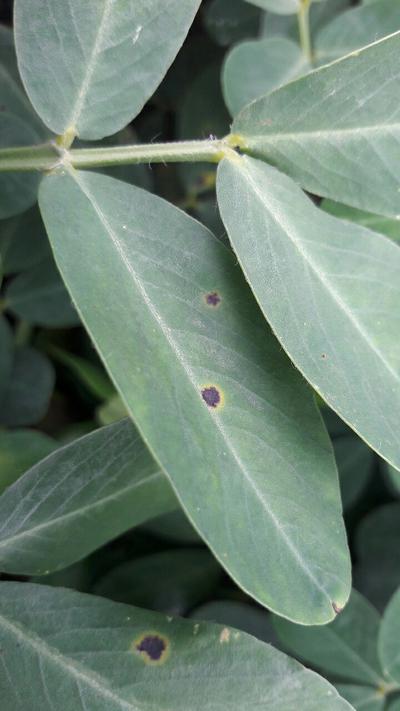Late and Early Leaf Spot
Mycosphaerella
Fungus
In a Nutshell
- Light brown spots with yellow halo (early).
- Dark spots (late).
- Spots turn darker and enlarge.
- Early - silvery, hair-like fungal growth on leaf top.
- Defoliation weakens stems and pegs.
Can also be found in
Symptoms
Circular spots on both sides of the leaves. Early leaf spot is characterized by light brown smooth lesions, that are often surrounded by yellow halos. Late leaf spot is characterized by rough dark brown or black lesions and halos are rarely present. As the disease progresses, the spots turn darker and grow larger (up to 10 mm), and start to appear on upper leaves, stems and pegs. In the case of early leaf spots, silvery, hair-like fungal growth sometimes can be observed on the top of the leaf. If environmental conditions are favorable, leaves eventually fall off and stems and pegs are weakened. The defoliation weakens the plant and its productivity. Harvesting losses increase as infected pegs lose strength and break during pulling and threshing at harvest.
Recommendations

Organic Control
The antifungal bacteria Bacillus circulans and Serratia marcescens can be applied to leaves to reduce the incidence of late leaf spot of peanut

Chemical Control
Always consider an integrated approach with preventive measures along with possible biological treatments. Fungicides containing chlorothalonil, tebuconazole, propiconazole azoxystrobin, pyraclostrobin, fluoxastrobin or boscalid can be used as foliar spray to control both diseases. For example, spraying of 3g/l mancozeb or 3g/l chlorothalonil when symptoms first start to appear and if necessary repeat spray after 15 days
What caused it?
Late and early leaf spot are two different diseases with similar symptoms that appear at different growth stages of the plant, thereby their respective names. They are caused by the fungi Mycosphaerella arachidis (early leaf spot) and Mycosphaerella berkeleyi (late leaf spot). Peanut plants are the only known host. The main source of inoculum are actually the residues of previous peanut crops. High humidities (dews), heavy rainfalls (or overhead irrigation) and warm temperatures (over 20°C) for long periods of time promote the infection and the progression of the disease. Late and early leaf spot are the most serious diseases of groundnut worldwide and can cause severe pod yield losses, singly or together.
Preventive Measures
- Plant resistant varieties available in your market.
- Destroy volunteer peanut crops in and around the field.
- Avoid overhead irrigation.
- Do not work in the field when plants are wet.
- Irrigate with adequate amounts of water and avoid frequent irrigation to maintain a drier canopy and soil surface.
- Implement crop rotation with non-host crops.
- Remove infected crop residues after harvest.



